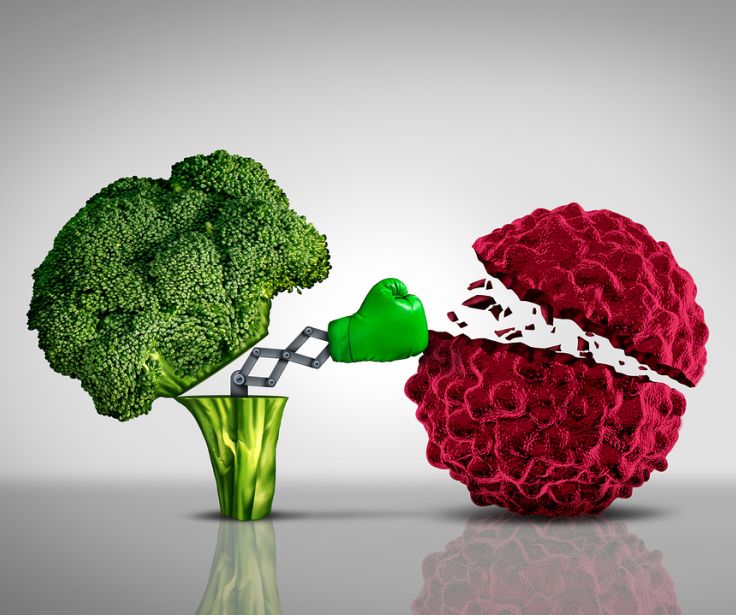
What's For Dinner?
Make dinner time, family time!
Article – Foods That Fight Cancer - Jump to recipe
Subscribe to our free weekly newsletter

What's For Dinner?
Make dinner time, family time!
Article – Foods That Fight Cancer - Jump to recipe
Subscribe to our free weekly newsletter

– Jean Fisher
Eat a wide variety of low-fat, high-fiber foods and include these nine super-foods often.
Share It!

Foods That Fight Cancer
To stay healthy, we should eat a wide variety of foods that include as many whole grains and fresh fruits and vegetables as possible. However, there are some foods that, through their chemical natures, are better at protecting the body from cancer. This article identifies nine of these super-foods, the natural components found in them, and a simplified description of how these phytochemicals work their magic.
But first, two very important dietary rules for avoiding cancer must be mentioned: low fat, high fiber.
A diet that is high in animal fats requires the body to release extra bile acids into the intestines during digestion. The natural bacteria that live in our intestines react with the excess bile acids resulting in the creation of carcinogens. Eating plenty of fiber keeps the intestines moving and eliminates these carcinogens before they can cause damage. In addition, fiber in the intestines actually binds with the bile acids not allowing them to react with the natural bacteria.
The human body is constantly producing unstable molecules called oxidants. These oxidants are often referred to as free radicals. Free radicals steal electrons from other molecules causing damage to the cell proteins and DNA of the original molecule. This damage leaves the cell vulnerable to cancer.
The active chemicals in food, called phytochemicals, are anti-oxidants. They search out the oxidants (free radicals) and prevent them from causing damage. In some instances, phytochemicals can even repair damage already done. Here's how it works:
Sulforaphane, found in broccoli and other cruciferous vegetables, boosts the body's natural cancer fighting properties. It does this by mobilizing special enzymes in the body called phase II detoxifying enzymes. These enzymes neutralize cancer-causing agents before they can affect cells.
Eat raw broccoli to receive the maximum benefit of sulforaphane. Scientists recently discovered that broccoli sprouts contain levels of sulforaphane that are much, much higher than those found in mature broccoli. You'll be seeing a lot more broccoli sprouts on my sandwiches and salads!
Another recent discovery in the science of plant chemicals is falcarinol found in carrots. Falcarinol acts as a natural pesticide for the carrot while it is growing, keeping it protected from fungal diseases. The exact mechanism that falcarinol uses to fight cancer is still unknown.
Capsaicin is the chemical in hot peppers that give them their bite. At a cellular level, capsaicin induces a state called apoptosis in the cancer cells. Apoptosis can be defined as programmed cell death. You could say that it causes the cancer cell to commit suicide.
Garlic contains the chemical allium which works to increase activity of our body's natural immune cells. Allium also causes cells to become more vulnerable to stress created by the by-products of cell division. Since cancer cells divide very rapidly, they are affected by allium more than normal cells, which divide much more slowly.
Nuts are one of nature's best sources of selenium. Selenium has been shown to improve the efficiency with which DNA repairs itself after exposure to damaging free radicals. Brazil nuts eaten from the shell are especially high in selenium. In addition, nuts contain omega-3 fatty acid. The omega-3 fatty acids block a protein that has been shown to increase sensitivity to carcinogens in laboratory studies.
Tip: keep your brazil nuts in the freezer. They are much easier to crack and extract from the shell when frozen. Allow to thaw before eating.
Anthocyanins, found in dark red and purple foods, can reduce the growth of an enzyme, human DNA topoisomerase II, that triggers the growth of cancer cells in the human body. Grape juice is an excellent source of anthocyanins. Good news, read the labels of 100% fruit drinks and you are very likely to find grape juice.
The phytochemical in soy, genistein, inhibits the growth of new blood vessels necessary for tumor survival. Without these blood vessels, the tumor shrinks. Soy also works to block bile acids. (Remember the relationship between bile acids and fats mentioned at the beginning of the article.)
Antioxidants in tea, catechins, appear to prevent cancer cells from dividing. The phytochemical EGCG (epigallocatechin gallate) present in green tea, binds to a protein found on tumor cells and dramatically slows their growth.
Lycopene, a very powerful antioxidant, isn't found in many other fruits and vegetables. Lycopene stimulates the production of phase II detoxification enzymes which neutralize carcinogens and allow them to be excreted out of the body. Processing tomatoes by turning them into sauce increases the levels of lycopene.
So remember, choose vegetable fats over animal fats, pack
your diet with a wide variety of fruits, vegetable and whole
grains, and include the nine foods mentioned above, often.
Live a long, healthy, happy life!
Our editor, Jean Fisher, is a former elementary teacher. She offers "What's For Dinner?" as a free service for busy families. One delicious meal is suggested for each day of the week, plus an organized grocery shopping list that can be customized to include all your shopping needs. You will also find two stimulating table topics and one educational after-dinner activity for each day.